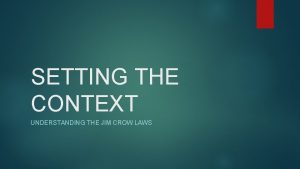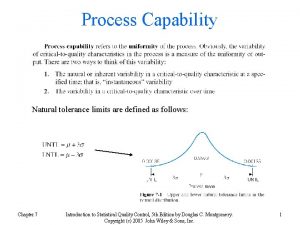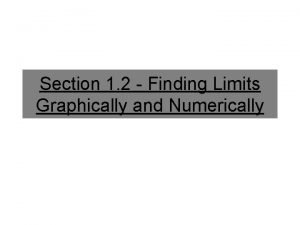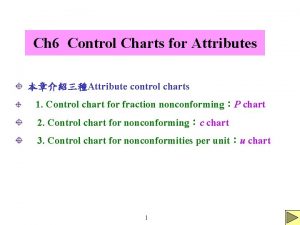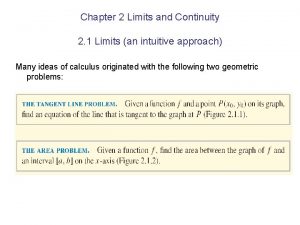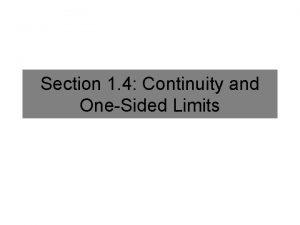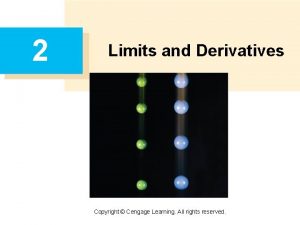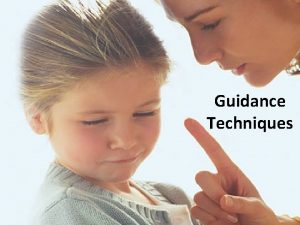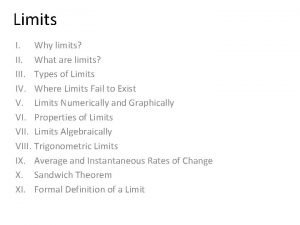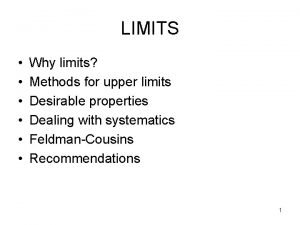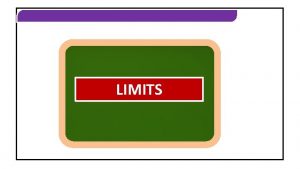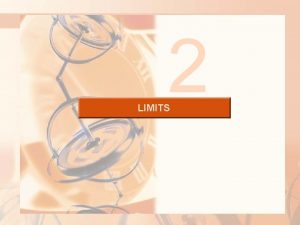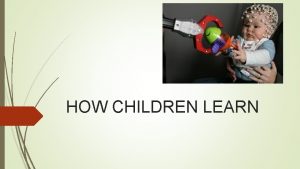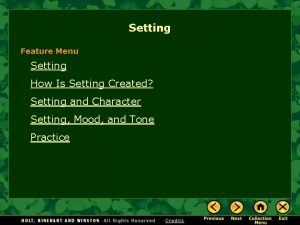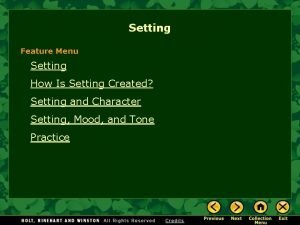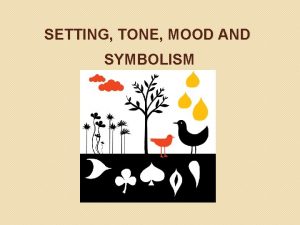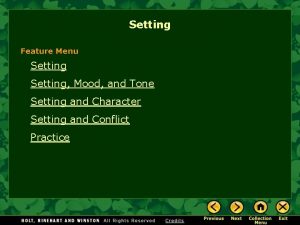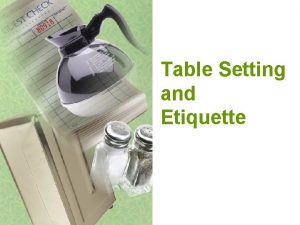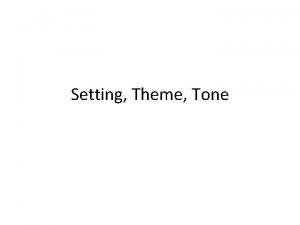Setting Limits with Children Setting Limits n n


























- Slides: 26

Setting Limits with Children

Setting Limits n n All children need limits set They all need guidance and boundaries n Limits can provide security and structure if done in a supportive manner The goal is to help children develop internal judgment so they can guide themselves n At a later age you don’t have to be setting external restraints or external limits Help children become thinkers so, if necessary, they can challenge rules later in life when they disagree

Setting Limits Help Us n Manage a child’s experimentation n n They need to explore within boundaries – whether it’s a two-year-old or a four-year-old or a six-year-old Deal with an immediate situation such as a tantrum when a child does not get the snack they wanted

Goals in Setting Limits n Create a sense of self n If every need is expected to be met or if all you experience are just punitive actions with hitting and spanking and isolation, this is going to affect your self-image – how you view yourself – and it’s going to affect the very definition of boundaries and of having a clear sense of where I end and someone else begins.

Goals in Setting Limits n Create a sense of self - Understand other people’s perspective (Theory of Mind) n The child whose expectations are never confronted with limits doesn’t develop a separation of where he ends and the rest of the world begins. This child expects the world to be part of him. Mom and Dad don’t have needs; only he has needs

Goals in Setting Limits n Create a sense of self n Through back-and-forth interactions where the child is constantly experimenting with the “me, ” the “I, ” the “self, ” doing things to the other and getting feedback and getting reactions (including limits)

When no limits are set! Can lead to fears and anxieties (a lack of security). n The lack of a response and a lack of limits may leave a child to be scared of anger and scared that anger can be too destructive because there’s no feedback early in life. n

Too many or harsh Limits If the feedback is overly punitive it can lead to a child who’s too scared to be assertive and his sense of an assertive sense of self is compromised n If the feedback is overly aggressive, verbally or physically, it will increase the child’s aggressive behavior n

Earn the right! n Give more to Expect more! n n Discipline and setting limits are something you earn the right to have. You earn that right by providing enough nurturance , love, compassion, and Floortime! Floortime: Following your child’s lead allows them to really feel you’re part of their universe, part of their life making them more responsive to your limits The child needs to feel secure and confident that you’re there, that you’re in their corner to learn from your limits

Earn the right! n Children, when feeling secure, want your respect! This happens early as they come to understand the difference between an admiring, approving look and a negative look. n Occurs between 12 and 24 months of life; it’s not something you have to wait to have until the child is four years old. n

Establish a Positive Relationship n Have Fun! n Show interest and enthusiasm in child’s interests n Listen, don’t judge or lecture n Sympathize and Empathize

Every Child is Unique Discipline has to be tailored to the child’s personality, to their emotional and sensory profile Most children are sensitive Be the “Gentile Giant”!

Sensitive Child n Emotional Quick to upset, 0 -60, fussy and finicky n Small emotional situations have a big impact, both good and bad. n n Sensory n Oversensitive in most or all sensory systems; touch, sight, sound, and sometimes movement

Sensitive Child n Method needs to be very gentle, persistent, but firm n You don’t want to throw fuel on the fire when the child’s already scared by being loud and too tough.

Active/Aggressive Child n Emotional n n Angry and aggressive feelings Some are frustrated and highly sensitive in some areas Others are craving lots of input Sensory n n n Underreactive to many sensory inputs, and actively seek them out, especially proprioceptive May get revved up by getting too much of these inputs May have one area of overreactivity, like visual

Active Child n You have to be providing alternative ways for the child to be able to use all that energy, all that need for movement n n You have to have lots of constructive ways to meet their sensory craving needs (positive emotional experience) Be there as part of the child’s life and you have to be firmer and sometimes more persistent for longer periods of time until the child gets the idea

Self Involved Child n Emotional Easy going, quiet, passive n May be thinking about own creative fantasies n Less social and more introverted n n Sensory Under reactive in most or all sensory systems; touch, sight, sound, and sometimes movement n May crave more of these inputs if provided, especially tactile, vestibular, and proprioceptive n

Self Involved Child Use affect to get the point across n Child may need some movement and sensory input in order to regulate and understand the limits that are being set n

Defiant Child n Emotional Stubborn, negative, controlling n Transitional problems n Rigid and clever n n Sensory Oversensitive in most or all sensory systems; touch, sight, sound, and sometimes movement n Relatively stronger visual, but weaker auditory processing compared to the sensitive child n

Defiant Make sure you are not overwhelming child n May try using more visuals to help the child understand their limits n Transition may further escalate the child n

Non-Verbal Child Need to calm and regulate when upset n Does not understand logic if working at few first milestones. Punishments are pointless! n n n Think of disciplining an 8 month old Once child can stay in continuous flow they can understand patterns of gestures n Respond to a frown or shaking of the head

Educate Child if Verbal You want to always educate the child n Reason for the discipline and make sure those conversations are two-way conversations, where the child gives his point of view and you can give your point of view n

What to do Always calm and soothe and help the child calm down first n Don’t discipline him in the middle of a tantrum n Discuss a little bit what just happened and then if the child has crossed the line and you feel discipline is in order, administer the discipline n

What to do Tough love approach is an extreme n Notion that adults are entitled to get their children’s respect and love and admiration n The children often harbor resentment and it affects their personalities n Avoid isolation or rejection. n A child who needs more discipline often is already feeling rejected and resentful and angry. n

What to do – Long Term Help the child move forward in development (up the milestones) n Improve their motor planning and processing n n Improving their language skills or improving their interactive skills gives the child more and more incentive to behave, and more tools to use to express themselves

Always Remember n Be Consistent and be Persistent (rather than punitive) n Use understanding with persistence and firmness. Be proportionate: Always modulate punishment to the crime n When you feel you’re losing it, because you’re only human, take a time out to relax, take a deep breath n Use pretend play or reality based n
 Limits involving infinity asymptotes
Limits involving infinity asymptotes Real limits vs. apparent limits
Real limits vs. apparent limits How to set limits on dts gate motor
How to set limits on dts gate motor Setting specification limits
Setting specification limits Understanding jim crow (setting the setting)
Understanding jim crow (setting the setting) Infinite limits examples
Infinite limits examples Natural tolerance limits in quality control
Natural tolerance limits in quality control Finding limits graphically and numerically
Finding limits graphically and numerically Parliament limits the english monarchy
Parliament limits the english monarchy Limits at infinity definition
Limits at infinity definition Pareto
Pareto Calculus chapter 2 limits and continuity answers
Calculus chapter 2 limits and continuity answers The limits of quantum computers
The limits of quantum computers The city limits of las pythagoras
The city limits of las pythagoras Limits of sequences
Limits of sequences Chapter 1 limits and their properties
Chapter 1 limits and their properties Proportion nonconforming formula
Proportion nonconforming formula Mpdu orientation seminar
Mpdu orientation seminar Cladding deflection limits
Cladding deflection limits Limits
Limits No limits eastern shore
No limits eastern shore Techniques for evaluating limits
Techniques for evaluating limits Parliament limits the english monarchy answer key
Parliament limits the english monarchy answer key Trigonometric limit identities
Trigonometric limit identities Nfpa 99 leakage current limits
Nfpa 99 leakage current limits Product law for limits
Product law for limits Limits
Limits




